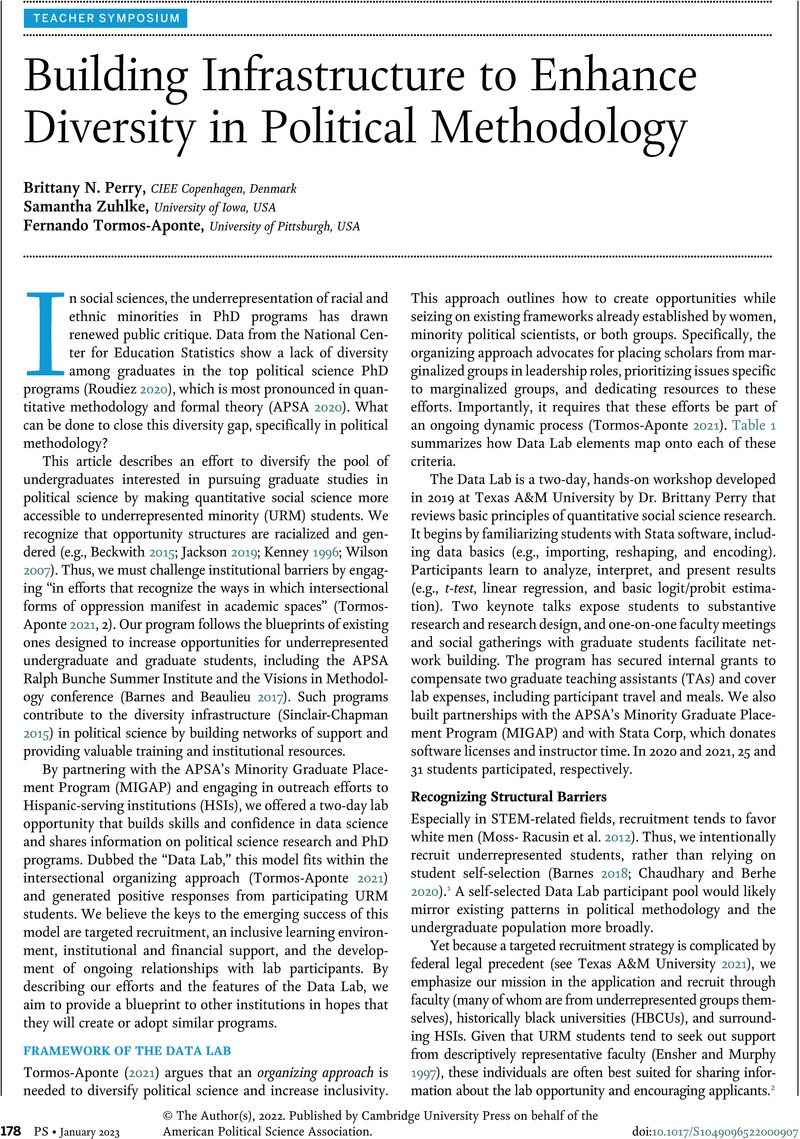No CrossRef data available.
Article contents
Building Infrastructure to Enhance Diversity in Political Methodology
Published online by Cambridge University Press: 29 August 2022
Abstract
An abstract is not available for this content so a preview has been provided. Please use the Get access link above for information on how to access this content.

- Type
- Structuring Inclusion into the Political Science Student Experience: From Recruitment to Completion, From Undergraduate to Graduate and Beyond
- Information
- Copyright
- © The Author(s), 2022. Published by Cambridge University Press on behalf of the American Political Science Association
References
Adida, Claire L., Lake, David A., Shafiei, Fatemeh, and Platt, Matthew. 2020. “Broadening the PhD Pipeline: A Summer Research Program for HBCU Students.” PS: Political Science & Politics 53(4): 723–28.Google Scholar
American Political Science Association. 2020. “APSA Membership.” https://www.apsanet.org/RESOURCES/Data-on-the-Profession/Dashboard/Membership.Google Scholar
Barnes, Tiffany D. 2018. “Strategies for Improving Gender Diversity in the Methods Community: Insights from Political Methodologists and Social Science Research.” PS: Political Science and Politics 51 (3): 580–87.Google Scholar
Barnes, Tiffany D., and Beaulieu, Emily. 2017. “Engaging Women: Addressing the Gender Gap in Women’s Networking and Productivity.” PS: Political Science and Politics 50 (3): 461–66.Google Scholar
Beckwith, Karen. 2015. “State, Academy, Discipline: Regendering Political Science.” PS: Political Science & Politics 48 (3): 445–49.Google Scholar
Blumenthal, Daniel S., Sung, John, Coates, Ralph, Williams, Jackie, and Liff, Jonathan. 1995. “Recruitment and Retention of Subjects for a Longitudinal Cancer Prevention Study in an Inner-City Black Community.” HSR: Health Services Research 30 (1): 197–205.Google Scholar
Chapman, Colin D., Benedict, Christian, and Schiöth, Helgi B.. 2018. “Experimenter Gender and Replicability in Science.” Science Advances 4 (1): e1701427.CrossRefGoogle Scholar
Chaudhary, V. Bala, and Berhe, Asmeret Asefaw. 2020. “Ten Simple Rules for Building an Antiracist Lab.” PLoS Computational Biolology 16 (10):1008210. doi:10.1371/journal.pcbi.1008210.CrossRefGoogle Scholar
Dickinson, Kesicia A., Jackson, Jasmine C., and Williams, Princess H.. 2020. “Jackson State University: Challenging Minds and Cultivating the Political Science Pipeline.” PS: Political Science & Politics 53 (1): 148–50.Google Scholar
Ensher, Ellen A., and Murphy, Susan E.. 1997. “Effects of Race, Gender, Perceived Similarity, and Contact on Mentor Relationships.” Journal of vocational behavior 50 (3): 460–81.CrossRefGoogle Scholar
Fairlie, Robert W., Hoffmann, Florian, and Oreopoulos, Philip. 2014. “A Community College Instructor like Me: Race and Ethnicity Interactions in the Classroom.” American Economic Review 104 (8): 2567–91.CrossRefGoogle Scholar
Hagedorn, Linda Serra, Chi, Winny YanFang, Cepeda, Rita M., and McLain, Melissa. 2007. “An Investigation of Critical Mass: The Role of Latino Representation in the Success of Urban Community College Students.” Research in Higher Education 48 (1): 73–91.CrossRefGoogle Scholar
Hathaway, Russel S., Nagda, Biren A. and Gregerman, Sandra R.. 2002. “The Relationship of Undergraduate Research Participation to Graduate and Professional Education Pursuit: An Empirical Study.” Journal of College Student Development 43 (5): 614–31.Google Scholar
Hoffmann, Florian, and Oreopoulos, Philip. 2009. “A Professor like Me: The Influence of Instructor Gender on College Achievement.” Journal of Human Resources 44 (2): 479–94.CrossRefGoogle Scholar
Jackson, Jenn M. 2019. “Breaking out of the Ivory Tower: (Re) Thinking Inclusion of Women and Scholars of Color in the Academy.” Journal of Women, Politics & Policy 40 (1): 195–203.Google Scholar
Kenney, Sally J. 1996. “New Research on Gendered Political Institutions.” Political Research Quarterly 49 (2): 445–66.CrossRefGoogle Scholar
Mealy, Kimberly A. 2015. “Forging Inclusive Diversity Coalitions within Associations.” Paper presented at the 2015 National Science Foundation Workshop on Coalition Building to Advance Diverse Leadership and Address Discrimination in Political Science and Law and Social Sciences. Arlington, VA, January 7–9.Google Scholar
Moore, Sharon E., Jones-Eversley, Sharon D., Tolliver, Willie F., Wilson, Betty L., and Jones, Christopher A.. 2022. “Six Feet apart or Six Feet under: The Impact of COVID-19 on the Black Community.” Death Studies 46 (4): 891–901.CrossRefGoogle Scholar
Morgenroth, Thekla, Ryan, Michelle K., and Peters, Kim. 2015. “The Motivational Theory of Role Modeling: How Role Models Influence Role Aspirants’ Goals.” Review of General Psychology 19 (4): 465–83.CrossRefGoogle Scholar
Moss-Racusin, Corinne A., Dovidio, John F., Brescoll, Victoria L., Graham, Mark J., and Handelsman, Jo. 2012. “Science Faculty’s Subtle Gender Biases Favor Male Students.” Proceedings of the National Academy of Sciences 109 (41): 16474–79.CrossRefGoogle Scholar
Museus, Samuel D. 2011. “Generating Ethnic Minority Student Success (GEMS): A Qualitative Analysis of High-Performing Institutions.” Journal of Diversity in Higher Education 4 (3): 147–62.CrossRefGoogle Scholar
Narayanan, Sathya, Cunningham, Kathryn, Arteaga, Sonia, Welch, William J., Maxwell, Leslie., and Bude, Zechariah Chawinga Su. 2018. “Upward Mobility for Underrepresented Students: A Model for a Cohort-Based Bachelor’s Degree in Computer Science.” Proceedings of the 49th ACM Technical Symposium on Computer Science Education 705–10.CrossRefGoogle Scholar
National Academies of Sciences, Engineering, and Medicine. 2018. English Learners in STEM Subjects: Transforming Classrooms, Schools, and Lives. Washington, DC: National Academies Press.Google Scholar
Roudiez, Chris (chris roudiez). October 17, 2020. “And another!! Even with significantly smaller graduate programs, sociology and political science both produce significantly more Black and Hispanic PhDs. Very insightful comparison of graduate program diversity using IPEDS data by @chris roudiez.” Twitter. https://twitter.com/TrevonDLogan/status/1317611597033050118/photo/3.Google Scholar
Sinclair-Chapman, Valeria. 2015. “Leveraging Diversity in Political Science for Institutional and Disciplinary Change.” PS: Political Science & Politics 48 (3): 454–58.Google Scholar
Texas A&M University. 2021. Stronger Together: A Report by the Commission on Diversity, Equity, and Inclusion. https://president.tamu.edu/committees-task-forces/commission-on-diversity-equity-and-inclusion/documents/CDEI_Final_Report_2021.pdf.Google Scholar
Tormos-Aponte, Fernando. 2021. “An Organizing Approach to Diversifying Political Science.” PS: Political Science & Politics 54 (1): 163–68.Google Scholar
Tormos-Aponte, Fernando, and Velez-Serrano, Mayra. 2020. “Broadening the Pathway for Graduate Studies in Political Science.” PS: Political Science & Politics 53 (1): 145–46.Google Scholar
Tsui, Lisa. 2007. “Effective Strategies to Increase Diversity in STEM Fields: A Review of the Research Literature.” Journal of Negro Education 76 (4): 555–81.Google Scholar
Williams, Joanna L., Elreda, Lauren Molloy, Henderson, Lora J., Deutsch, Nancy L., and Lawrence, Edith C.. 2019. “Dyadic Connections in the Context of Group Mentoring: A Social Network Approach.” Journal of Community Psychology 47 (5): 1184–96.CrossRefGoogle Scholar
Wilson, George. 2007. “Racialized Life-Chance Opportunities across the Class Structure: The Case of African Americans.” Annals of the American Academy of Political and Social Science 609 (1): 215–32.CrossRefGoogle Scholar




